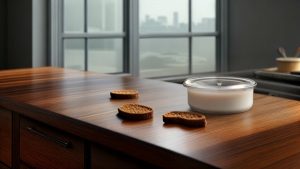Maintaining clean and shiny kitchen cabinets is essential for any home cook or chef. However, sticky and greasy residue can accumulate quickly, making it challenging to keep cabinets looking pristine. In this expert guide, we will provide you with tips and techniques for effectively cleaning sticky, greasy kitchen cabinets.
Our guide will cover everything from understanding the causes of sticky, greasy cabinets to choosing the right cleaning solution and polishing and protecting your cabinets. We will also provide you with general maintenance and prevention tips to ensure your cabinets remain clean and shiny in the long term.
Key Takeaways:
- Regular cleaning is essential for maintaining clean and shiny kitchen cabinets.
- Understanding the causes of sticky, greasy cabinets is crucial for effective cleaning.
- Choosing the right cleaning solution and tools is necessary for a thorough cleaning.
- Polishing and protecting kitchen cabinets is essential after cleaning.
- General maintenance and prevention tips can help prevent sticky, greasy residue from accumulating.
Understanding the Causes of Sticky, Greasy Cabinets
If you are wondering how to clean sticky, greasy kitchen cabinets, it is important to understand the reasons behind the problem. Grease and grime can accumulate on cabinets due to various factors, such as cooking oil splatters, food spills, and even airborne particles. Over time, these substances can create a sticky residue that is difficult to remove.
Effective grease removal methods require a thorough understanding of the causes of sticky, greasy cabinets. Knowing the root of the problem can help you prevent it from occurring in the first place and tackle it more efficiently when it does. Here are some of the most common causes of sticky, greasy cabinets:
| Cause | Effect |
|---|---|
| Cooking oil splatters | Leave unsightly stains and sticky residue on cabinets above cooking surfaces. |
| Food spills | Can attract dirt and dust and create a breeding ground for bacteria, leading to more stubborn stains and grime. |
| Buildup of kitchen grime | Combination of airborne particles, cooking vapors, and everyday use can lead to a buildup of sticky residue on cabinets. |
Removing grease from cabinets requires regular cleaning and maintenance, as well as effective grease removal methods. By understanding the causes of sticky, greasy cabinets, you can take proactive measures to prevent them and keep your cabinets looking clean and shiny.
Essential Tools and Materials for Cabinet Cleaning
Keeping kitchen cabinets clean is essential for maintaining a healthy home environment. The accumulation of grease and grime not only affects the appearance of the cabinets but can also lead to the growth of harmful bacteria. That’s why it’s crucial to have the right tools and materials for effective cabinet cleaning.
Here are some of the best cleaning products for kitchen cabinets:
| Product | Description |
|---|---|
| All-Purpose Cleaner | A versatile cleaner that can be used on various surfaces, including kitchen cabinets. Look for cleaners that are free of harsh chemicals and safe for the environment. |
| Vinegar | A natural cleaning solution that can help remove grease and grime on cabinets. Mix equal parts of vinegar and water in a spray bottle and use it to clean the cabinets. |
| Baking Soda | Another natural cleaning solution that is effective in removing tough stains on cabinets. Mix baking soda with a small amount of water to form a paste. Apply the paste to the stains and let it sit for a few minutes before wiping it off with a damp cloth. |
In addition to cleaning products, it’s important to have the right tools for cleaning kitchen cabinets. Here are some essential tools you’ll need:
- Microfiber cloths: These are ideal for dusting and wiping down cabinets without leaving streaks or scratches.
- Soft-bristled brush: Use this to remove dirt or grime from tight corners or grooves in the cabinets.
- Vacuum cleaner: Use a handheld vacuum cleaner to remove loose dust or debris from the cabinet surfaces.
- Step ladder: A step ladder will help you reach the top shelves of your cabinets easily and safely.
While commercial cleaning products are effective, you may prefer natural cabinet cleaners that are free of harsh chemicals. Not only are they environmentally friendly, but they are also safe for your family, especially if you have children or pets.
Some of the best natural cleaning products for kitchen cabinets include:
- Lemon and baking soda: A mixture of lemon juice and baking soda can help remove stains and grime from cabinets. Apply the paste to the cabinets and let it sit for a few minutes before wiping it off with a damp cloth.
- Olive oil: This natural oil can be used to polish wooden cabinets and give them a beautiful shine. Apply a small amount of olive oil to a microfiber cloth and rub it gently on the cabinets.
- Castile soap: This natural soap is made from vegetable oil and can be used to clean cabinets effectively. Mix a small amount of castile soap with water and use it to clean the cabinets.
Conclusion
Having the right tools and materials is essential in keeping your kitchen cabinets clean and shiny. Whether you prefer commercial cleaning products or natural cleaners, make sure to select the ones that are safe for your cabinets and your family. By following the tips and using the recommended products in this guide, you’ll be able to keep your kitchen cabinets free from sticky, greasy residue.
Preparing the Cabinets for Cleaning
Before beginning the deep cleaning process, it’s important to prepare the cabinets for easy and efficient cleaning. This means removing all items from the cabinets, emptying the contents and organizing them in a safe place. Ensure that all the items are out of the way to avoid any mess or accidental damage.
The next step is to declutter the cabinets and dust off any loose debris or dirt. Use a microfiber cloth or a soft-bristled brush to remove any dust or cobwebs from the cabinet surfaces. This will ensure that the cabinets are fully cleaned and prevent any missed spots. Additionally, removing the dust will make cleaning much easier as the dust will not mix with the cleaning solution making sticky residues.
Once the cabinets are decluttered and dust-free, it’s time to remove any remaining items such as hardware, drawers, and shelves for a thorough cleaning. Clean all the removed items separately and let them dry. This is important to ensure the entire cabinet is cleaned, and no residue is left over anywhere in the cabinet.
By following these steps, you will be able to ensure that your cabinets are ready for a deep cleaning, making the process more efficient and ensuring that all areas of the cabinets are cleaned effectively.
Testing and Choosing the Right Cleaning Solution
Before diving into the cleaning process, it’s essential to test and choose the right cleaning solution for your sticky, greasy cabinets. The wrong cleaning product can damage the cabinet material or fail to remove the buildup, making the cleaning process more challenging.
Here are some tips on testing and selecting the right cleaning solution:
- Test in inconspicuous areas: Before using any cleaning solution on your cabinets, test it in an inconspicuous area to ensure it doesn’t cause any damage or discoloration to the cabinet material. Wait for a few minutes after applying the solution and wipe it off with a clean cloth to check for any side effects.
- Choose the right cleaning solution: The type of cleaning solution you use will depend on the cabinet material and the level of stickiness and greasiness. For most kitchen cabinets, a mild dish soap or a commercial degreaser will work well. However, some cabinet materials, such as wood, may require special cleaners or natural solutions like vinegar or baking soda.
- Don’t use abrasive cleaners: Avoid using abrasive cleaners, steel wool pads, or harsh chemicals on your cabinets, as they can scratch or damage the surface. Stick to gentle, non-abrasive cleaners and soft cloths or sponges for effective cleaning.
- Consider homemade cleaning solutions: If you prefer natural cleaning solutions, you can try making your own cleaners using ingredients like vinegar, baking soda, lemon juice, or essential oils. These cleaners can be just as effective as commercial products and are often safer for your health and the environment.
By testing and choosing the right cleaning solution, you can ensure that your cabinets are effectively cleaned without causing any damage to the material.
Pro tip:
If you’re dealing with extremely sticky or greasy residue, try using a solution of equal parts vinegar and water or baking soda and water. Apply the solution to the affected areas and let it sit for a few minutes before wiping it off with a damp cloth. Repeat as necessary until the residue is gone.
Cleaning the Exterior of Kitchen Cabinets
DIY cabinet cleaning can help homeowners save money and ensure their kitchen cabinets are properly cleaned. However, it is important to use the right techniques and products to avoid damaging the cabinet finishes. Here’s how to clean the exterior of kitchen cabinets:
Cleaning Wood Cabinets
For wood cabinets, use a soft cloth or sponge and a solution of warm water and mild soap. Wring out the cloth or sponge before wiping down the cabinets in the direction of the wood grain. Avoid using abrasive cleaners or cloths that can scratch the wood finish. Dry the cabinets with a clean, dry cloth.
Cleaning Laminate Cabinets
Laminate cabinets are relatively easy to clean with warm water and mild detergent. Avoid using abrasive or acidic cleaners that can damage the surface. Wipe down the cabinets with a soft cloth or sponge and dry them off with a clean, dry cloth. To remove stubborn stains, use a baking soda paste and a soft-bristled brush.
Cleaning Painted Cabinets
Painted cabinets should be cleaned with a soft cloth or sponge and a mild cleaning solution. Avoid using abrasive or acidic cleaners that can damage the paint. Always test a small, inconspicuous area first before cleaning the entire cabinet. Dry the cabinets with a clean, dry cloth.
Removing Stubborn Stains and Sticky Residue
For stubborn stains and sticky residue, use a non-abrasive cleaner specifically designed for the cabinet material. Apply the cleaner to a soft cloth or sponge and work it into the stain or residue in a circular motion. Rinse the area with clean water and dry it off with a clean, dry cloth.
By following these tips for cleaning the exterior of kitchen cabinets, homeowners can keep their cabinets looking great for years to come.
Deep Cleaning the Interior of Kitchen Cabinets
Deep cleaning the inside of kitchen cabinets can be a daunting task, but it’s important for maintaining a hygienic and organized kitchen. Here are the steps to follow:
Step 1: Remove Shelves and Drawers
Start by emptying the contents of your cabinets and removing the shelves and drawers. This will enable you to clean every nook and cranny of the cabinets effectively. Take care to label each shelf and drawer to make their arrangement easier during reassembly.
Step 2: Clean the Interior Cabinet Surface
Use a soft cloth and a suitable cleaning solution to wipe down the interior cabinet surface. Be sure to test the cleaning solution in an inconspicuous area before proceeding. For stubborn stains, mix baking soda with water to form a paste. Apply the paste on the stains and let it sit for a few minutes before wiping it off with a cloth.
Step 3: Clean the Shelves and Drawers
Clean the shelves and drawers separately using a suitable cleaning solution. Take care to remove any crumbs or food particles that may have gathered inside the shelves and drawers.
Step 4: Clean the Hardware
Clean the hardware such as knobs and handles with a suitable cleaning solution. If the hardware is particularly dirty or greasy, you can remove it for a more thorough cleaning. Just be sure to label each piece so that you can put it back in the right place.
Step 5: Reassemble the Cabinets
After cleaning, allow the cabinets, shelves, drawers, and hardware to dry completely before reassembling. Then, replace the shelves and drawers, and organize your items before closing the cabinets. Take care to avoid overfilling the cabinets to prevent sticky and greasy residue from accumulating again.
By following these steps, you can deep clean the interior of your kitchen cabinets and maintain a hygienic and organized kitchen. Regular deep cleaning, at least twice a year, will ensure that your cabinets remain free of dust, grime, and sticky residue.
Polishing and Protecting Kitchen Cabinets
Polishing and protecting kitchen cabinets is an important final step in the cleaning process to keep them clean and shiny for longer. Here are some tips to help you achieve a professional finish:
Choosing the Right Product:
When selecting a product to polish and protect your cabinets, it is essential to choose one that is compatible with the type of material used in your cabinets. For wooden cabinets, use a high-quality furniture wax that does not contain silicones or petroleum. For painted or laminate cabinets, use a non-yellowing polish for a protective finish. Avoid using abrasive cleaners or polishes as they can damage the surface of your cabinets.
Applying the Product:
Polishing and protecting your cabinets is easy. Simply apply the product to a soft cloth and use it to wipe down the surface of your cabinets. Ensure that the product is distributed evenly and use a dry cloth to remove any excess polish or wax. For best results, apply the product in a thin, even layer and allow it to dry before buffing it with a clean, dry cloth.
Maintaining Clean and Shiny Cabinets:
To keep your kitchen cabinets clean and shiny, it is essential to maintain a regular cleaning routine. Wipe down the surface of your cabinets each week with a soft cloth or sponge and a mild cleaner. Avoid using abrasive or acidic cleaners as they can damage the surface of your cabinets. Use protective liners inside your cabinets to protect them from spills and stains.
By following these simple tips, you can keep your kitchen cabinets looking clean and shiny for years to come!
General Maintenance and Prevention Tips
To keep your kitchen cabinets clean and free from sticky, greasy residue, it’s important to establish a regular cleaning routine. Here are some tips to help keep your cabinets looking their best:
- Wipe down the exterior of cabinets regularly with a damp cloth to remove dust and grime.
- Use protective liners on cabinet shelves to prevent spills and stains.
- To prevent sticky residue buildup, avoid placing hot and steamy pots and pans directly on cabinet surfaces.
- Be mindful of spills and clean them up promptly to prevent stains and residue buildup.
- Use microfiber cloths or sponges for cleaning, as they are gentle and effective at removing dirt and grease.
- For tough stains or residue, use a non-abrasive cleaner that is safe for your cabinet material. Test the cleaner in an inconspicuous area first.
- Avoid using harsh chemicals or abrasive scrubbers that can damage cabinet finishes.
- Regularly dust and declutter the interior of cabinets to prevent the accumulation of dirt and grease.
- Organize cabinet contents in a way that makes it easy to access and clean each item.
- Finally, be mindful of common mistakes that can lead to sticky, greasy cabinets, such as using too much cleaning solution or leaving cabinet surfaces wet for too long.
By following these simple tips, you can maintain clean and shiny kitchen cabinets that will enhance the overall look and feel of your kitchen.
Tackling Stubborn Residue and Stains
Despite your best efforts, there may be times when stubborn residue or stains refuse to budge from your kitchen cabinets. Here are some effective grease removal methods and techniques to tackle such tough spots:
1. Vinegar and Baking Soda
A mixture of vinegar and baking soda can work wonders in removing tough stains and grease buildup on kitchen cabinets. Mix equal parts of white vinegar and baking soda and apply the solution to the affected area with a soft cloth. Let it sit for a few minutes, then wipe it off with a clean, damp cloth.
2. Dish Soap and Warm Water
Mix a few drops of dish soap with warm water and use the solution to remove stubborn grease stains. Apply the mixture to a soft cloth and scrub gently, taking care not to damage the cabinet surface. Rinse with a clean, damp cloth and dry immediately.
3. Oil Soap
An oil soap solution can be effective in removing sticky residue on wood cabinets. Apply a small amount of oil soap to a damp cloth and wipe the cabinet surface in the direction of the grain. Rinse with a clean, damp cloth and dry immediately.
4. Commercial Cleaners
If homemade solutions do not work, consider using commercial cleaners specifically designed for removing grease and grime on kitchen cabinets. Look for products that are safe for your cabinet material and test them on a small, inconspicuous area first.
By using these effective grease removal methods, you can tackle even the toughest stains and residue on your kitchen cabinets. Remember to always test solutions in a small area before applying to the entire cabinet surface.
Conclusion
Keeping your kitchen cabinets clean and free from sticky, greasy residue may seem like a daunting task, but with the right tools and techniques, it can become a routine part of your cleaning regimen. By understanding the causes of sticky cabinets, choosing the right cleaning solutions, and following the steps outlined in this expert guide, you can achieve clean and shiny cabinets that will elevate the overall look of your kitchen.
Remember to regularly clean and maintain your cabinets, and to follow the prevention tips provided to avoid future buildup of grease and grime. With a little effort and attention, your kitchen cabinets can become a source of pride and a reflection of your commitment to cleanliness and organization.
FAQ
Q: How often should I clean my kitchen cabinets?
A: It is recommended to clean your kitchen cabinets at least once a month to prevent the buildup of sticky, greasy residue.
Q: What is the best cleaning product for kitchen cabinets?
A: There are several great options for cleaning kitchen cabinets, including multi-purpose cleaners, vinegar and water solution, and specialized cabinet cleaners. Choose a product that is safe for your cabinet material.
Q: Can I use natural cleaners to clean my kitchen cabinets?
A: Yes, there are natural cleaning solutions such as vinegar, baking soda, and lemon juice that can effectively clean kitchen cabinets. These options are often safer for the environment and provide a chemical-free cleaning alternative.
Q: How do I remove sticky residue from my cabinets?
A: To remove sticky residue, you can use a mixture of warm water and mild dish soap. Apply the solution to a clean cloth and gently scrub the sticky area. Rinse with clean water and dry thoroughly.
Q: What should I do if my cabinets have stubborn stains?
A: For stubborn stains, you can try using a non-abrasive cleaner or a baking soda paste. Apply the cleaner directly to the stain and gently scrub with a soft cloth or sponge. Rinse and dry the area afterwards.
Q: Should I remove the cabinet hardware before cleaning?
A: It is recommended to remove cabinet hardware, such as knobs and handles, before cleaning to ensure a thorough and even cleaning. Clean the hardware separately using appropriate cleaning methods.
Q: How do I maintain the shine of my kitchen cabinets?
A: After cleaning, you can use a cabinet polish or furniture wax to restore the shine of your kitchen cabinets. Apply the polish following the manufacturer’s instructions and buff gently with a clean cloth.
Q: Can I use abrasive cleaners on my cabinets?
A: It is best to avoid using abrasive cleaners on kitchen cabinets as they can damage the finish. Stick to mild, non-abrasive cleaners and gentle cleaning techniques to preserve the quality of your cabinets.
Q: Are there any preventive measures to avoid sticky cabinets?
A: Yes, you can use protective liners on cabinet shelves and drawers to prevent spills and stains. Regularly wipe down surfaces, especially near the cooking area, to prevent grease buildup. Avoid placing sticky or greasy items directly on cabinet surfaces.
Q: How can I tackle persistent greasy residue?
A: If you are dealing with persistent greasy residue, you can try using a degreaser specifically formulated for kitchen surfaces. Follow the instructions on the degreaser and ensure proper ventilation during use.

It’s me, Amber Hayden, the heart and soul behind SagarmathaOnlineMedia.com. From a young age, I’ve been head over heels for everything home-related, from interior decor to gardening. I’m the type who can’t resist a well-crafted piece of furniture, and I firmly believe that a home isn’t complete without a pet or two. But it’s not just about creating pretty spaces for me. I’m all about making homes that tell a story reflecting the people living there. SagarmathaOnlineMedia.com is my way of sharing this passion with you. Whether you’re looking for tips to jazz up your living room, advice on pet care, or ideas to make your garden bloom, I’m here to help. So, let’s embark on this journey together and make your house a home!



